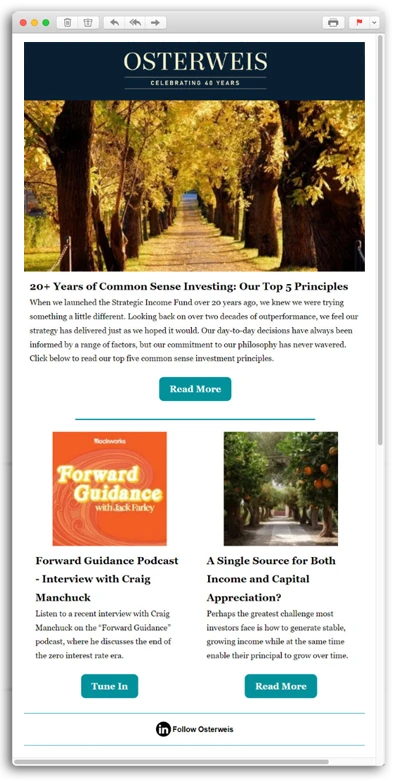Price Makers, Share Gainers, and Compounding Machines: Three Quality Business Models
As high conviction, active managers we believe that owning a select group of quality companies is the most effective long-term investment strategy. In our view, fundamentally sound businesses are more likely to outperform in both up and down markets.
The challenge, of course, is consistently finding these types of companies and buying them at the right price – ideally when they are out of favor with the market or when growth opportunities are not properly discounted in a company’s valuation. Determining whether a company is truly high quality is complicated, and requires more than just analyzing financial statements, economic conditions, and regulatory issues.
In our experience, one of the most important investment criteria, and also one of the most underappreciated, is the strength of a company’s underlying business model. We spend a considerable amount of time assessing this, not only because it is difficult to evaluate, but also because we believe it has an outsized impact on returns. In general, we prefer to invest in one of the following three types of businesses:
- Price makers - companies with pricing power
- Share gainers - companies that leverage low cost leadership to consistently grow market share
- Compounding machines - companies that do both
For us to invest in a company, it generally must fit into one of these categories.
Price Makers: Companies with Pricing Power
Warren Buffett, the vaunted investor who compounded annual shareholder returns at Berkshire Hathaway Inc. at a stunning 20% from 1965-2020, has long pointed to pricing power as a key indication of business quality. In fact, he said in 2011 that:
Basically, the single most important decision in evaluating a business is pricing power. If you’ve got the power to raise prices without losing business to a competitor, you’ve got a very good business. And if you have to have a prayer session before raising the price by 10%, then you’ve got a terrible business. I’ve been in both, and I know the difference.
Said another way, companies that can charge more without losing market share have durable pricing power and thus are generally very high quality. This dynamic sounds simple, but it is relatively rare and incredibly powerful because revenues generated from price increases tend to flow straight through to the bottom line, creating higher margins even if nothing else about the business changes. Companies that can achieve this feat can therefore drive highly profitable growth for years, but these companies must offer real value. Otherwise, customers will find less expensive alternatives. Furthermore, cheaper competitors will clamor in to pick off unhappy customers.
For pricing power to remain durable, companies need to have a meaningful competitive advantage. Often this can take the form of strong network effects that create high switching costs, regulatory barriers to entry, technological differentiation, brand value, or some other structural advantage.
By our estimate, roughly one-third of our portfolio falls into the price maker category. These high-quality businesses typically are dominant within their industry and possess significant pricing power over time, have high incremental margins, and exhibit attractive consolidated return on invested capital (ROIC).
Share Gainers: Low Cost Providers With Growing Market Share
Given Buffett’s extraordinary track record and his seemingly definitive statement that pricing power is “the single most important decision in evaluating a business,” one might think that business quality is all about charging high prices. However, this is far from the full story.
In fact, some of Buffett’s greatest investments have been in businesses that consistently undercut competitors and lower prices for customers. Just consider GEICO or Costco Wholesale Corporation: these are businesses that for years have provided critical goods and services (insurance and retail products, respectively) at prices customers cannot find elsewhere. These companies are in the business of offering industry low prices to ensure happy customers who come back again and again. Notably, both companies exhibit low operating margins and do not exert pricing power, which might lead one to conclude these are low quality businesses.
What makes them high quality is that they systematically increase their sales volume by taking market share from competitors. As long as the industries they operate in are flat to growing, the companies taking share enjoy steady revenue growth at stable but relatively low margins. The winners are able to do this in a capital-efficient manner, driving very attractive returns.
To maintain durable market share growth, companies have to possess a meaningful competitive advantage. Often this can take the form of a hard to replicate operating model, economies of scale, or first mover advantage.
By our estimate, roughly half our portfolio falls into the share gainer category. These high-quality companies typically combine lower prices and operational efficiency to take market share from incumbents with less competitive legacy business models. They tend to generate attractive revenue growth through expanding market share while maintaining stable but modest profit margins and have high unit level ROIC.
Compounding Machines: Pricing Power and Market Share Growth
A rare breed of companies can both consistently raise price and take market share – we call these businesses “compounding machines.” This very powerful combination typically results in high revenue growth and even higher profit growth due to attractive incremental margins.
Few companies fit this dynamic. In our view, those that do often operate in relatively narrow sectors of the economy, provide a critical good or service to their customers, and are typically considered the premium provider in their market.
Compounding machines tend to have multiple competitive advantages. For example, they often have network effects and a proprietary operating model or a technology advantage and brand strength. This combination can ensure years of continued market share gains coupled with robust pricing power.
By our estimate, just under a fifth of our portfolio falls into this category. These businesses tend to generate attractive revenue growth through share take, see expanding profit margins, and exhibit high unit level ROIC.
The Importance of Competitive Advantage
If we sound like a broken record on the concept of competitive advantage, it is because we obsess over this idea. Every investment we consider has to have a durable, lasting, and demonstrable competitive advantage. Understanding the durability of this competitive advantage is key to underwriting continued pricing power and/or market share growth, and we devote most of our research efforts towards this endeavor.
We frequently revisit the thesis for every company we own to test its structural advantage. Key to this analysis is monitoring pricing, market share flows, margins, and other financial information. We also carefully consider strategic transactions that happen in the sectors our companies operate in to understand if competitive dynamics have changed or could change in the future. In addition, we periodically check in with customers, suppliers, and other stakeholders to assess whether our companies enjoy the same advantages they historically have. Lastly, we closely monitor competitors and potential insurgents to understand whether new threats are emerging.
Evaluating a company’s competitive advantage is as much art as science and does not come down to a simple checklist, as companies and industries are in a constant state of evolution and change. However, by remaining fully engaged and, frankly, paranoid, we think we can maintain a solid grasp on what competitive advantage each company has and how much runway exists.
Tying It All Together
Every analysis, research project, and investing conversation on the Core Equity team revolves around competitive advantage. We always seek to quantify competitive advantage and believe that the vast majority of high-quality businesses exhibit durable pricing power while maintaining market share or operate as a low cost provider consistently growing market share in a profitable way. A rare breed of companies we refer to as “compounding machines” both exert pricing power and grow market share profitably. Our strategy seeks to build a concentrated portfolio of high-quality companies that fall under this framework at compelling valuations.
Nael Fakhry
Co-Chief Investment Officer – Core Equity
Osterweis Fund Quarter-End Performance (as of 9/30/25)
| Fund | 1 MO | QTD | YTD | 1 YR | 3 YR | 5 YR | 10 YR | 15 YR | 20 YR |
INCEP (10/1/1993) |
|---|---|---|---|---|---|---|---|---|---|---|
| OSTFX | 1.29% | 4.14% | 9.05% | 8.34% | 17.11% | 9.88% | 10.22% | 9.68% | 7.88% | 10.31% |
| S&P 500 Index | 3.65% | 8.12% | 14.83% | 17.60% | 24.94% | 16.47% | 15.30% | 14.64% | 10.97% | 10.79% |
Gross expense ratio as of 3/31/25: 0.96%
Performance data quoted represent past performance; past performance does not guarantee future results. The investment return and principal value of an investment will fluctuate so that an investor’s shares, when redeemed, may be worth more or less than their original cost. Current performance of the Fund may be higher or lower than the performance quoted. Performance data current to the most recent month end may be obtained by calling shareholder services toll free at (866) 236-0050.
Rates of return for periods greater than one year are annualized.
Where applicable, charts illustrating the performance of a hypothetical $10,000 investment made at a Fund’s inception assume the reinvestment of dividends and capital gains, but do not reflect the effect of any applicable sales charge or redemption fees. Such charts do not imply any future performance. During the period noted, fee waivers or expense reimbursements were in effect for the Osterweis Fund.
The S&P 500 Index is widely regarded as the standard for measuring large cap U.S. stock market performance. The index does not incur expenses, is not available for investment, and includes the reinvestment of dividends.
References to specific companies, market sectors, or investment themes herein do not constitute recommendations to buy or sell any particular securities.
There can be no assurance that any specific security, strategy, or product referenced directly or indirectly in this commentary will be profitable in the future or suitable for your financial circumstances. Due to various factors, including changes to market conditions and/or applicable laws, this content may no longer reflect our current advice or opinion. You should not assume any discussion or information contained herein serves as the receipt of, or as a substitute for, personalized investment advice from Osterweis Capital Management.
Complete holdings of all Osterweis mutual funds (“Funds”) are generally available ten business days following quarter end. Holdings and sector allocations may change at any time due to ongoing portfolio management. Fund holdings as of the most recent quarter end are available here: Osterweis Fund
Growth & Income Fund Quarter-End Performance (as of 9/30/25)
| Fund | 1 MO | QTD | YTD | 1 YR | 3 YR | 5 YR | 10 YR | 15 YR |
INCEP (8/31/2010) |
|---|---|---|---|---|---|---|---|---|---|
| OSTVX | 1.10% | 3.43% | 8.31% | 7.73% | 12.97% | 8.81% | 8.61% | 8.76% | 9.00% |
| 60% S&P 500 Index/40% Bloomberg U.S. Aggregate Bond Index | 2.63% | 5.66% | 11.43% | 11.67% | 16.71% | 9.62% | 9.99% | 9.77% | 10.10% |
| S&P 500 Index | 3.65% | 8.12% | 14.83% | 17.60% | 24.94% | 16.47% | 15.30% | 14.64% | 15.21% |
| Bloomberg U.S. Aggregate Bond Index | 1.09% | 2.03% | 6.13% | 2.88% | 4.93% | -0.45% | 1.84% | 2.26% | 2.25% |
Gross expense ratio as of 3/31/25: 0.91%
Performance data quoted represent past performance; past performance does not guarantee future results. The investment return and principal value of an investment will fluctuate so that an investor’s shares, when redeemed, may be worth more or less than their original cost. Current performance of the Fund may be higher or lower than the performance quoted. Performance data current to the most recent month end may be obtained by calling shareholder services toll free at (866) 236-0050.
Rates of return for periods greater than one year are annualized.
Where applicable, charts illustrating the performance of a hypothetical $10,000 investment made at a Fund’s inception assume the reinvestment of dividends and capital gains, but do not reflect the effect of any applicable sales charge or redemption fees. Such charts do not imply any future performance. During the period noted, fee waivers or expense reimbursements were in effect for the Growth & Income Fund.
Source for any Bloomberg index is Bloomberg Index Services Limited. BLOOMBERG® is a trademark and service mark of Bloomberg Finance L.P. and its affiliates (collectively “Bloomberg”). Bloomberg owns all proprietary rights in the Bloomberg Indices. Bloomberg does not approve or endorse this material, or guarantees the accuracy or completeness of any information herein, or makes any warranty, express or implied, as to the results to be obtained therefrom and, to the maximum extent allowed by law, neither shall have any liability or responsibility for injury or damages arising in connection therewith.
The 60/40 blend is composed of 60% S&P 500 Index (S&P) and 40% Bloomberg U.S. Aggregate Bond Index (Agg) and assumes monthly rebalancing. The S&P is widely regarded as the standard for measuring large cap U.S. stock market performance. The Agg is widely regarded as a standard for measuring U.S. investment grade bond market performance. These indices do not incur expenses and are not available for investment. These indices include reinvestment of dividends and/or interest income.
References to specific companies, market sectors, or investment themes herein do not constitute recommendations to buy or sell any particular securities.
There can be no assurance that any specific security, strategy, or product referenced directly or indirectly in this commentary will be profitable in the future or suitable for your financial circumstances. Due to various factors, including changes to market conditions and/or applicable laws, this content may no longer reflect our current advice or opinion. You should not assume any discussion or information contained herein serves as the receipt of, or as a substitute for, personalized investment advice from Osterweis Capital Management.
Complete holdings of all Osterweis mutual funds (“Funds”) are generally available ten business days following quarter end. Holdings and sector allocations may change at any time due to ongoing portfolio management. Fund holdings as of the most recent quarter end are available here: Growth & Income Fund
Opinions expressed are those of the author, are subject to change at any time, are not guaranteed and should not be considered investment advice.
Mutual fund investing involves risk. Principal loss is possible. The Osterweis Fund may invest in medium and smaller sized companies, which involve additional risks such as limited liquidity and greater volatility. The Fund may invest in foreign and emerging market securities, which involve greater volatility and political, economic and currency risks and differences in accounting methods. These risks may increase for emerging markets. The Fund may invest in Master Limited Partnerships, which involve risk related to energy prices, demand and changes in tax code. The Fund may invest in debt securities that are un-rated or rated below investment grade. Lower-rated securities may present an increased possibility of default, price volatility or illiquidity compared to higher-rated securities. Investments in debt securities typically decrease in value when interest rates rise. This risk is usually greater for longer-term debt securities.
The Osterweis Funds are available by prospectus only. The Funds’ investment objectives, risks, charges, and expenses must be considered carefully before investing. The summary and statutory prospectuses contain this and other important information about the Funds. You may obtain a summary or statutory prospectus by calling toll free at (866) 236-0050, or by visiting www.osterweis.com/statpro. Please read the prospectus carefully before investing to ensure the Fund is appropriate for your goals and risk tolerance.
Dividend payments are not guaranteed.
Earnings growth is not representative of the fund’s future performance.
Return on invested capital (ROIC) is a calculation used to assess a company’s efficiency at allocating the capital under its control to profitable investments.
Return on equity is the amount of net income returned as a percentage of shareholders equity.
Osterweis Capital Management is the adviser to the Osterweis Funds, which are distributed by Quasar Distributors, LLC. [OSTE-20210308-0165]


